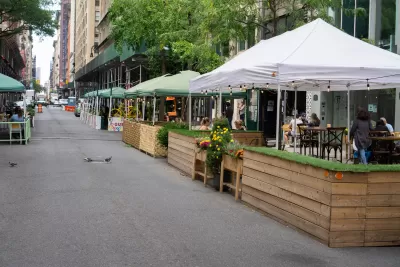The funding is designed to support open streets and public space projects in underresourced neighborhoods.

The New York City Department of Transportation (NYCDOT) will spend almost $30 million to support open streets programs around the city, with part of the money slated to help neighborhoods with lower capacity and smaller volunteer bases to maintain or create open streets in their communities.
As Kevin Duggan explains in Streetsblog NYC, “This mayor and his successor were criticized for not supporting the legions of volunteers who program the new public spaces and set up and take down barricades every day — work that some said should be done by the city.” Now, “DOT plans to spend $27 million over three years to contract managers and crews to work on one or several sites, depending on their size, helping with basic operations, like sweeping, bagging trash, moving barricades, planting, and providing access for people with disabilities.”
In the early days of the pandemic, open streets became an effective way to support local restaurants and small businesses, help people safely spend more time outdoors, and encourage community-building while adhering to pandemic restrictions. Today, only 25 of Mayor de Blasio’s promised 100 miles of open streets remain, mostly in whiter, wealthier parts of the city.
For neighborhoods with fewer resources, the daily tasks of managing open streets projects is left up to a small cadre of volunteers, and some open streets face backlash from residents and businesses, despite evidence that open streets and outdoor dining initiatives have boosted economic activity in the city. The new funding could help provide key services to communities lacking deep-pocketed business improvement districts (BIDs) or other funding sources.
FULL STORY: HOOPLA: City Adds $30M for Managing Open Streets, Public Space in Needy Nabes

Alabama: Trump Terminates Settlements for Black Communities Harmed By Raw Sewage
Trump deemed the landmark civil rights agreement “illegal DEI and environmental justice policy.”

Study: Maui’s Plan to Convert Vacation Rentals to Long-Term Housing Could Cause Nearly $1 Billion Economic Loss
The plan would reduce visitor accommodation by 25% resulting in 1,900 jobs lost.

Why Should We Subsidize Public Transportation?
Many public transit agencies face financial stress due to rising costs, declining fare revenue, and declining subsidies. Transit advocates must provide a strong business case for increasing public transit funding.

Paris Bike Boom Leads to Steep Drop in Air Pollution
The French city’s air quality has improved dramatically in the past 20 years, coinciding with a growth in cycling.

Why Housing Costs More to Build in California Than in Texas
Hard costs like labor and materials combined with ‘soft’ costs such as permitting make building in the San Francisco Bay Area almost three times as costly as in Texas cities.

San Diego County Sees a Rise in Urban Coyotes
San Diego County experiences a rise in urban coyotes, as sightings become prevalent throughout its urban neighbourhoods and surrounding areas.
Urban Design for Planners 1: Software Tools
This six-course series explores essential urban design concepts using open source software and equips planners with the tools they need to participate fully in the urban design process.
Planning for Universal Design
Learn the tools for implementing Universal Design in planning regulations.
Smith Gee Studio
Alamo Area Metropolitan Planning Organization
City of Santa Clarita
Institute for Housing and Urban Development Studies (IHS)
City of Grandview
Harvard GSD Executive Education
Toledo-Lucas County Plan Commissions
Salt Lake City
NYU Wagner Graduate School of Public Service





























